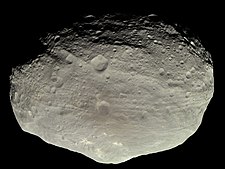4 Vesta

Color image of Vesta taken by Dawn
|
|
| Discovery | |
|---|---|
| Discovered by | Heinrich Wilhelm Olbers |
| Discovery date | 29 March 1807 |
| Designations | |
| Pronunciation | /ˈvɛstə/ |
|
Named after
|
Vesta |
| Main belt (Vesta family) | |
| Adjectives | Vestan, Vestian |
| Orbital characteristics | |
| Epoch 2014-Dec-09 (JD 2457000.5) | |
| Aphelion | 2.57138 AU |
| Perihelion | 2.15221 AU |
| 2.36179 AU | |
| Eccentricity | 0.08874 |
| 3.63 yr (1325.75 d) | |
|
Average orbital speed
|
19.34 km/s |
| 20.86384° | |
| Inclination | 7.14043° to ecliptic 5.56° to invariable plane |
| 103.85136° | |
| 151.19853° | |
| Satellites | None |
| Proper orbital elements | |
|
Proper semi-major axis
|
2.36151 AU |
|
Proper eccentricity
|
0.098758 |
|
Proper inclination
|
6.39234° |
|
Proper mean motion
|
99.1888 deg / yr |
|
Proper orbital period
|
3.62944 yr (1325.654 d) |
|
Precession of perihelion
|
36.8729 (2343 years) arcsec / yr |
|
Precession of the ascending node
|
−39.5979 (2182 years) arcsec / yr |
| Physical characteristics | |
| Dimensions |
(572.6 × 557.2 × 446.4) ± 0.2 km 525.4±0.2 km (mean) |
| Flattening | 0.2204 |
| (8.66±0.2)×105 km2 | |
| Volume | (7.46±0.3)×107 km3 |
| Mass | (2.59076±0.00001)×1020 kg |
|
Mean density
|
(3.456 ± 0.035) g/cm³ |
| 0.25 m/s2 0.025 g |
|
| 0.36 km/s | |
| 0.2226 d (5.342 h) | |
|
Equatorial rotation velocity
|
257.5 m/s |
| Albedo | 0.423 (geometric) |
| Temperature |
min: 85 K (−188 °C) max: 270 K (−3 °C) |
|
Spectral type
|
V-type asteroid |
| 5.1 to 8.48 | |
| 3.20 | |
| 0.70″ to 0.22″ | |
Vesta, minor-planet designation 4 Vesta, is one of the largest objects in the asteroid belt, with a mean diameter of 525 kilometres (326 mi). It was discovered by the German astronomer Heinrich Wilhelm Olbers on 29 March 1807 and is named after Vesta, the virgin goddess of home and hearth from Roman mythology.
Vesta is the second-most-massive and second-largest body in the asteroid belt after the dwarf planet Ceres, and it contributes an estimated 9% of the mass of the asteroid belt. It is slightly larger than Pallas, though significantly more massive. Vesta is the last remaining rocky protoplanet (with a differentiated interior) of the kind that formed the terrestrial planets. Numerous fragments of Vesta were ejected by collisions one and two billion years ago that left two enormous craters occupying much of Vesta's southern hemisphere. Debris from these events has fallen to Earth as howardite–eucrite–diogenite (HED) meteorites, which have been a rich source of information about Vesta.
Vesta is the brightest asteroid visible from Earth. Its maximum distance from the Sun is slightly greater than the minimum distance of Ceres from the Sun, though its orbit lies entirely within that of Ceres.
NASA's Dawn spacecraft entered orbit around Vesta on 16 July 2011 for a one-year exploration and left orbit on 5 September 2012 en route to its final destination, Ceres. Researchers continue to examine data collected by Dawn for additional insights into the formation and history of Vesta.
Heinrich Olbers discovered Pallas in 1802, the year after the discovery of Ceres. He proposed that the two objects were the remnants of a destroyed planet. He sent a letter with his proposal to the English astronomer William Herschel, suggesting that a search near the locations where the orbits of Ceres and Pallas intersected might reveal more fragments. These orbital intersections were located in the constellations of Cetus and Virgo. Olbers commenced his search in 1802, and on 29 March 1807 he discovered Vesta in the constellation Virgo—a coincidence, because Ceres, Pallas, and Vesta are not fragments of a larger body. Because the asteroid Juno had been discovered in 1804, this made Vesta the fourth object to be identified in the region that is now known as the asteroid belt. The discovery was announced in a letter addressed to German astronomer Johann H. Schröter dated 31 March. Because Olbers already had credit for discovering a planet (Pallas; at the time, the asteroids were considered to be planets), he gave the honor of naming his new discovery to German mathematician Carl Friedrich Gauss, whose orbital calculations had enabled astronomers to confirm the existence of Ceres, the first asteroid, and who had computed the orbit of the new planet in the remarkably short time of 10 hours. Gauss decided on the Roman virgin goddess of home and hearth, Vesta.
...
Wikipedia
